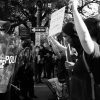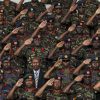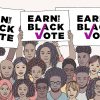
There are relatively few detailed, firsthand accounts of the 12 million Africans captured and forcibly transported to the Americas in the 400 years of the trans-Atlantic slave trade. Of the 10 million survivors of that journey, only a very small number, like Olaudah Equiano, Venture Smith and Job Ben Solomon, lived long enough—or had the time or opportunity—to write about their experiences.
To date, though, we know of only one African who wrote an account of his capture and enslavement in Brazil, the destination for 40 percent of all slaves who made that perilous Atlantic crossing between 1519 and 1867, when the slave trade finally ended in fact as well as in law.
For that reason alone, Mahommah Gardo Baquaqua’s Biography and description of the notorious Middle Passage would be worth exploring. But Baquaqua’s 1854 narrative also reveals a remarkable journey that took him to Haiti, upstate New York, Canada and England. In these places he was legally free but not at peace, because he was not at home. According to the Irish abolitionist Samuel Moore, who assisted him in writing and publishing his work, Baquaqua talked “much of Africa” and prayed ardently that he would one day return.

Home, according to Baquaqua’s Biography, was the city of Zoogoo, now known as Djougou, a large city in the interior of the present-day West African nation of Benin. The Bight of Benin was one of the major ports of slave departures, responsible for the transportation of over 2 million Africans to the Western Hemisphere—a quarter of them, like Baquaqua, after the official ending of the slave trade in 1807.
As his first name, “Mahommah,” indicates, he was born a Muslim. His father, a Nigerian-born merchant, was “not very dark complexioned,” according to his description, and was said to be of “Arabian” descent. His mother, “entirely black,” came from Katsina in northern Nigeria, which was on a major caravan trade route in West Africa. Exactly how or why she traversed the 700 miles from Katsina to Djougou, where her husband made his home, is a reminder that 19th-century Africa was a very mobile society, shaped not only by the slave trade but by internal changes as well.
Baquaqua devotes much of the early part of his narrative to a description of the Islamic faith practiced by his devout family in Djougou, including the observance of Ramadan. He attended a Quranic school run by his uncle, but he proved to be a poor student and, so, apprenticed as a blacksmith. Again he chafed at the discipline needed to succeed, so around the age of 15, he found work as a porter on the 350-mile trade route to Dagomba, a province of the Asante Kingdom in Ghana.
There, he was captured during a war in the early 1840s but released when his ransom was paid. He then returned to Djougou and worked in the palace of a local nobleman as a tkiriku (bodyguard). He also looted and plundered local properties to provision the palace.
Perhaps significantly, Baquaqua’s narrative does not state that he was a slave, even though most tkiriku at that time were. He may have been ashamed of that fact (and of the role of his fellow Africans in his enslavement). He certainly regretted abandoning his strict Muslim faith for a position in which he stole and drank alcohol, for which he was to pay the ultimate price with the loss of his freedom. Drunk after taking part in a raid on a nearby village, he fell asleep and was kidnapped into slavery.
Baquaqua was then sold south, across 300 miles, by several traders and through three owners before arriving in the busy port of Ouidah, on Benin’s Atlantic coast, around 1845. To evade British naval patrols seeking to enforce the global ban on the slave trade, Baquaqua and his fellow slaves were moved to a nearby lagoon, where they were “all put into a pen … and to insure obedience, a man was placed in front with a whip in his hand ready to strike the first who should dare to disobey orders; another man then went round with a hot iron, and branded us the same as they would the heads of barrels or any other inanimate goods or merchandize.”
Baquaqua recalls that the slaves were then “chained together, and tied with ropes round about our necks, and were thus drawn down to the sea shore. I had never seen a ship before, and my idea of it was, that it was some object of worship of the white man. I imagined that we were all to be slaughtered, and were being led there for that purpose.” Around 30 of his fellow slaves bound for “that most horrible of places … the slave ship” drowned on the way. Baquaqua made it, only to endure several weeks of cramped, diseased conditions in the hold of the ship and a daily diet of boiled corn and a pint of water. Several slaves were thrown overboard as too sickly to sell before the vessel arrived at Pernambuco in northeastern Brazil.
Baquaqua was then sold to a local baker, who tasked him first with moving heavy stones (on his head) to build a house and then, once he had learned some Portuguese, to sell bread, day and night, whipping his slave severely if any remained unsold. Baquaqua drank heavily and contemplated running away, killing his master and committing suicide. Within a year he was sold south to a ship’s captain in Rio de Janeiro, where he scrubbed decks. By the summer of 1847, Baquaqua was serving aboard the Lembrança, a vessel shipping coffee to New York.
By then he had learned enough Portuguese to know that he was headed to a port where slavery was illegal, and he was determined to seek his freedom as soon as the boat landed. He attempted to flee the ship but was imprisoned for several weeks after a New York judge decided that Baquaqua should be returned to his owner. He then escaped, perhaps aided by local abolitionists, and made his way to Massachusetts, where he had a choice of traveling to England or Haiti.
Believing that it would have a better climate, he chose the latter, the Western Hemisphere’s only free black republic. Haiti was still, however, a foreign land and at the time was embroiled by President Solouque’s violent repression of the political opposition. Baquaqua struggled with the Kreyol (Haitian Creole) language and finding work but eventually established a relationship with white American Free Baptists in Port-au-Prince, in hopes that they would send him back to West Africa to serve as a missionary. Just how committed a Baptist he was is unclear—Baquaqua used his Muslim first name throughout his life—but he appears to have found the Baptist faith, with its emphasis on temperance, more congenial than the Roman Catholicism he had been forced to accept in Brazil.
To avoid being drafted into the Haitian army, Baquaqua returned to the United States between 1849 and 1853. In McGraw, a village in upstate New York, he attended New York Central College, a Baptist institution that was one of the nation’s first to have a faculty and student body integrated by race and gender. Despite the college’s ideals, Baquaqua faced racial prejudice. His relationship with the daughter of a local white minister provoked much open hostility, and he struggled with his studies.
Chafing at the lack of economic opportunities, he traveled extensively throughout upstate New York to promote the Baptists’ plan to send him to Africa as a missionary. When that plan failed to be realized, he moved to Canada in 1853, where he published his biography to publicize his struggles and desire to go back to his homeland. Baquaqua left for Liverpool, England, in 1855, hoping to secure passage to the British colony of Sierra Leone. He disappears from the historical record two years later, still in England. Whether he achieved his goal of returning to Africa, for which he had struggled from the moment of his capture 12 years earlier, is unknown.
Edited by Henry Louis Gates Jr. and Evelyn Brooks Higginbotham, the African American National Biography was first published by Oxford University Press in an award-winning, eight-volume print edition in 2008; a 12-volume second edition followed in 2012. As of 2015, more than 5,500 separate AANB entries are available online as part of OUP’s African American Studies Center. This biography was adapted from the AANB entry.
Steven J. Niven is executive editor of the Dictionary of Caribbean and Afro-Latin American Biography, the Dictionary of African Biography, and the African American National Biography at Harvard University’s Hutchins Center for African and African American Research. He is also the author of Barack Obama: A Pocket Biography of Our 44th President.














